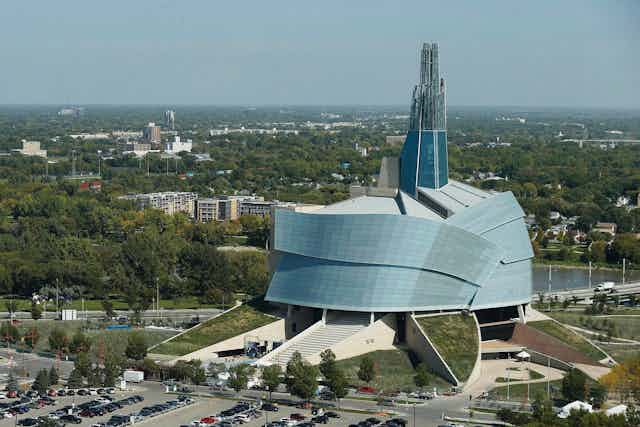The Canadian Museum for Human Rights has been in the news for all the wrong reasons. It has joined the ranks of several prominent institutions, from Rideau Hall to the Montréal Museum of Fine Arts, that have been rocked by allegations of discrimination and harassment.
The human rights museum is no stranger to controversy. Many issues from its early years are now part of the public record. In 2012, prominent human rights lawyer and scholar Mary Eberts denounced government interference in the museum and its failure to integrate adequately Indigenous perspectives and agency in the development of the galleries.
Until 2015, the federal Conservative government attempted to interfere with content, pushing instead for “more positive stories,” as law professor Ken Norman wrote in the 2015 anthology, The Idea of a Human Rights Museum.
I served as an external adviser and peer reviewer for the museum over several years. The current crisis may be shocking, but it’s a predictable consequence of the museum’s history of separating strategic management practices from human rights principles.
The allegations have been circulating on social media under the hashtag #CMHRStopLying. They also include incidents from January 2015 to mid-2017, when museum staff agreed to censor LGBTQ2+ content at the request of religious groups. The ensuing public uproar prompted the museum’s CEO, John Young, to step down. The board of trustees launched an independent third-party review.
Racism is ‘pervasive and systemic’
On July 31, 2020, the board received an interim report from that review that they made public on Aug. 5. The report draws on staff interviews and contains 44 recommendations. It says that racism is “pervasive and systemic.” It confirms that Black and Indigenous people and people of colour have experienced adverse impacts, and reports incidents of heterosexism, homophobia and sexism. (The board of trustees will be the focus of a second report.)
The report has been accepted by the board of trustees.
It contains wide-ranging recommendations for diverse representation at all levels of the museum, including the CEO. It speaks to the importance of reconciliation with Indigenous Peoples, and has a strong focus on inclusivity and community engagement in content and policy development. The report also notes that “front-facing” staff who interact with the public and develop programs generally have a strong interest or backgrounds in human rights. Management, on the other hand, generally do not, and see the museum as focused on “revenue generation.”
The disconnect between staff and senior management highlighted in the report resonates. So does the concern about commercial success and corporate engagement at the expense of substantive human rights programming.
The fact that years of incidents recounted in the report should have escaped the board of trustees’ notice speaks at the very least to a dysfunctional relationship between senior management and the board. That’s something for which the board is ultimately responsible.
The report is not without its flaws. It refers to equality in terms of “formal equality” instead of “substantive equality.” Formal equality has not been the legal standard in Canada for many years, while substantive equality has been established as the correct approach by the Supreme Court of Canada.
The distinction matters because equality should not simply mean that everyone is treated the same way at all times. Rather, a substantive approach recognizes people’s differences and that different approaches may be needed to achieve equality.

These issues do not detract from the overwhelming and serious problems within the museum that the report highlights. However, there are other key issues that flow from the museum’s status as a national institution and its governance history. Next steps must actively address its vulnerability to external pressure and self-censorship.
My own experience points to the importance of strengthening relationships with Canadian human rights NGOs. Over the years, prominent leaders in Canada’s human rights community have expressed to me their frustration at the lack of openness by the museum to engage with human rights defenders today, or to engage with current issues and strategies to mobilize community action.
The museum must regain not only the public’s trust, but also that of its staff, who have worked for years to build stakeholder relations. Their efforts have been reduced to ashes.
Reconnecting to human rights
This moment in time offers an opportunity to reclaim and re-establish the museum as a respected mediator of difficult conversations and “difficult histories,” as scholar Ruth B. Phillips says in her research on the portrayal of and engagement with Indigenous Peoples in Canadian museums.
Indeed, the museum’s place at the very nexus of memory, discourse and dissent sharpens rather than resolves vexing questions about what human rights “count,” whose stories are given prominence and why.
Human rights-based approaches should be integrated into management thinking. Connecting strongly and authentically with civil society is part of a participatory approach. This means increasing engagement with civil society and racialized communities. Otherwise, the museum risks becoming timid, merely perpetuating illusions of understanding and progress.
The human rights scholar David Petrasek had thought deeply about the museum’s role in Canada. As he once reminded us, there is something both “dangerous and illuminating” about human rights. The commitment of Pauline Rafferty, the board chair and interim CEO at the museum, to reclaim principles of human dignity and respect are hopeful signs that a more daring exploit is possible.
The appointment on Aug. 10 of new president and CEO Isha Khan, a lawyer with human rights expertise, is another promising signal.
The Canadian Museum for Human Rights should reject the inherent caution and orthodoxy of institutional governance that is typical of federal institutions, and replace it with the kind of radical democracy and transparency that human rights principles demand. It would be an experiment. But it is one that would reconnect strategic governance to human rights principles.

